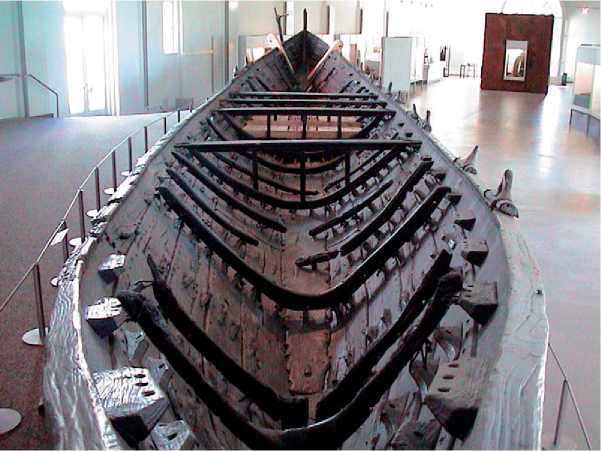Although nautical archaeology (maritime archaeology) is considered to have began with the recovery in 1900 of various art objects, Rhodian and Coan amphorae, an astronomical device, and other small objects from a first century BC shipwreck off the islet of Antikythera, the beginnings can be pushed back well into the nineteenth century when several ‘flagships of nautical archaeology’ were investigated and/ or excavated: in 1863, K. Engelhardt completed the wetland excavation of a spectacular fourth century AD derelict at Nydam, in Southern Jutland, Denmark (Figure 1); in Norway, the majestic graved vessels that
Came to symbolize the ships of the marauding Vikings came to light at Borre (1850-52), Tune (1867), Gokstad (1880), and Oseberg (1904); while in the British Isles, J. Deane and C. W. Parsley led the first organized efforts of recording and salvaging several shipwrecks (HMS Royal George, Mary Rose, Colossus, Venerable, etc.) sunk around the coastlines of the British Isles. These early benchmarks in the history of nautical archaeology, followed afterward by other twentieth century important excavations (Hjortspring on Als (1921), Lake Nemi ‘barges’ (1928-32), Sutton Hoo (1939), etc.) predicted in fact the blooming phase of nautical archaeology that came to pass after the 2nd International Congress of Underwater Archaeology from Albenga in 1958. The initiation of systematic investigations of Roman period shipwrecks like Mahdia (1948; investigations led by J. Y. Cousteau and E. Poidebard), Antheor (1948), Albenga (1950, 1957), Grand Conglous; (1952-56; by a diving team led by J. Y. Cousteau and F. Benoit), ), La Chretienne A (1953-54, 1962), Titan (1956-58), Dramont (1956-59), and Spargi (1958) created the necessary practical framework onto which an original methodological breakthrough was developed within nautical archaeology during the following decades. The documentation and/or recovery of the early seventeenth century Swedish man-of-war Wasa (1956-61) a brilliant engineering project resulting for the first time in the recovery of an intact hull from the seabed; the recording in situ and the recovery in 1957-60 of five sunken and broken vessels near Skuldelev, Denmark; the excavation in 1960 of the Late Bronze Age (c. BC 1200) shipwreck

Figure 1 Nydam B displayed at the Gottorf Castle in Schleswig. Photo: G. Indruszewski.
From Gelidonya, which was ‘‘the first shipwreck excavation carried out to completion on the sea bed, the first directed by a diving archaeologist, and the first conducted following the standards of terrestrial excavation’’ (Bass 1996: 29); the excavation and documentation of the two Byzantine shipwrecks off the Yassi Ada islet, Turkey; the 1967-69 excavation of the fourth century BC Greek merchant vessel off Kyrenia, Cyprus; the documentation, raising, and conservation of Henry Vlll’s warship, the Mary Rose during 1965-79; the excavation of the Zwammerdam derelicts in the Netherlands (1968-71); the remote sensing investigations of the Titanic (1985-96); the investigation of Quanzhou (1975) and Shinan Gun (1975-76) vessels in the Far East; the excavation of the HMS Pandora in Australian waters (1977-2001); the excavation and preservation in Israel (Sea of Galilee) of the ‘Jesus boat’ (1986-1995); the excavation of the Late Bronze Age (c. BC 1340-30) sunken vessel at Uluburun (1984-95); and the investigations of the Early Helladic II (c. BC 2200) shipwreck from Dokos in Greece (1989-92) opened a mature period in the history of the new scientific discipline, where the accent fell not only on the technical aspects of excavation and recording, but also on the education of the general public coupled with the creation of an institutional and legal framework able to support the work of future generations of nautical archaeologists. The expansive number of institutions and individuals working within nautical and maritime archaeology (see Maritime Archaeology) led to the creation of maritime archaeology programs at numerous universities and the establishment of several forums of discussion, the most important being the International Journal of Nautical Archaeology (IJNA) and the organization of regular international conferences (the International Symposium of Boat and Ship Archaeology (ISBSA), TROPIS). Changes in legislation on national, regional, and international level helped in the establishment of an effective legal shield that protect any sites with hull remains, effectively supporting the creation of marine sanctuaries and the establishment of museums/depart-ments with marine profile in Europe, Australia, Asia, the Near East, and the Americas, represented globally by the International Congress of Maritime Museums (ICMM).




 World History
World History









